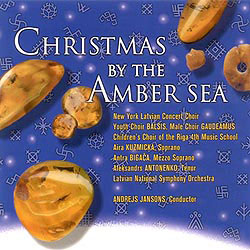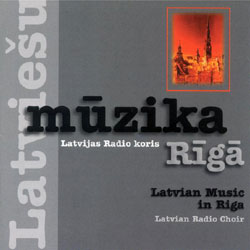
After half a century of official disparagement and outright criminalization in the Baltic States, Christmas has returned, with its joyous and hopeful sights, sounds, and traditions. While we in the West continued to celebrate and enrich this heritage during those years, the people of Eastern Europe have only been able to do so again freely in the last decade, since the demise of Communism.
For many years, a major contributor to the choral repertoire for the Christmas season has been the New York Latvian Concert Choir. Since the early 1980s it has commissioned and premiered a new Christmas cantata from a different Latvian composer every year. In 1997 the choir released an album containing five of these works. Now Christmas By the Amber Sea has appeared with two more, by Jānis Lūsēns and Ilze Akerberga, as well as a work by 40-year-old Estonian composer Urmas Sisask.
Sisask’s “Christmas Oratorio” dates from 1992. Lasting just shy of 37 minutes, it is divided into 21 short, vividly contrasting movements setting traditional Latin texts recounting Christ’s birth. With skillful, imaginative writing, it grabs the listener’s attention from the outset. A large ensemble dominated by the sharp, bright colors of recorders, harpsichord, organ and piano is carefully and lucidly scored, with small groups of instruments often used to colorful effect. Choral and solo sections are punctuated by several purely instrumental interludes as the work progresses without any extraneous gestures, keeping the listener’s attention focused throughout. Rhythmic propulsiveness, clear textures and frequent contrasts occasionally bring the music of Carl Orff (of “Carmina Burana” fame) to mind.
An all-Estonian performance of the original version with male chorus was released several years ago on the Antes label. Though both recordings are excellent, the newer one sounds richer and fuller, with female soloists’ diction much clearer. However, sung Latin in neither performance entirely follows international standards, with irritatingly local pronounciation of some sounds.
Ilze Akerberga was born in New York City in 1953 and is a musician who conveys her ideas with great sensitivity and skill. Her “Winter Cantata” is half as long as Sisask’s oratorio, with spare, effective textures in a warm, simple style. Six contrasting movements set words by five Latvian poets, reflecting on the snowy northern winter landscape and the mood of the holiday season, often as seen through the eyes of a child (two movements are sung by a children’s choir). While not directly addressing the birth of Christ, “the overall concept [of the work] suggests the close interaction of God’s world with that of man,” in the words of Kathryn Livingston’s excellent progam notes, and the choice of texts underlines the inextricable associations for Balts between Christmas, the winter season, and the winter solstice. Composed in 1981, this is a loving work of great warmth and sincerity.
Born in 1959 in Liepāja, Latvia, Jānis Lūsēns is the composer of the final work on this album, a 1997 cantata titled “Child of the Stars.” Similar in conception to Akerberga’s cantata, it does not address Christmas directly, but rather reflects on the impressions the holiday evokes at different stages in life, with texts by four different Latvian poets.
While it is a lovely work that begins promisingly, I ultimately found it to be less compelling than the other works on the album. Perhaps those works’ more distinctive profiles invite unfair comparison? I found my attention repeatedly drifting in the middle of the work, though the appearance of the children’s choir in the final section provided welcome contrast and brought the work to a satisfying conclusion.
Performances on this album are vivid, sung and played with verve and enthusiasm. Soloists Antra Bigača, Aira Kuzmicka and Aleksandrs Antonenko are wonderful, and a children’s choir and recorder ensemble, both from Riga, sing and play with professionalism. The New York Latvian Concert Choir, together with two renowned Riga choirs, Gaudeamus and Balsis, produce a rich and clear sound. All these forces as well as the Latvian National Symphony Orchestra are led with passionate commitment by Andrejs Jansons in finely nuanced readings.
A beautifully packaged, well-filled recording with superb graphic design, fine notes and fully translated texts—what more could anyone ask for?
Details
Christmas By the Amber Sea
New York Latvian Concert Choir
New York Latvian Concert Choir, 2000
NYLCC 003





